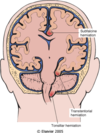Causes of Seizures 1/16 Flashcards
(46 cards)
Types of brain herniation

Subfalcine herniation
may compress ant. cerebral art.
transtentorial herniation
may compress:
1) CNIII= see ipsilateral dilated pupil and impaired eye movement
2) post. cerebral art.= primary visual cortex
3) cerebral peduncle=kernohan’s notch, ipsilateral hemiparesis
4) pons and midbrain= duret hemorrhage due to vessel tearing–>life threatening
tonsillar herniation
brain stem compression–>cardiac and respiratory centers
NO LP if CT shows:
mid-line shift, loss of CSF cisterns, post. fossa mass–>high risk of herniation
CT without contrast
hemorrhage/hematoma, skull fx/trauma, hydrocephalus, fluid accumulation/abscess
CT with contrast
tumor(angiogenesis), vascular malformation, infection/inflammation
intracranial hemorrhage
related to HTN and peak age is 60. most frequent sites: thalamus, basal ganglia, pons and cerebellum
Charcot-bouchard micro aneurysms
associated with chronis HTN. Minute aneurysms in small vessels which can rupture
subarachnoid hemorrhage
caused by bleeding from cerebral arterial aneurysms. bleeding is at arterial pressure. “The worst headache of my life” then loss of consciousness. re-bleeding is common among survivors.
Acute: vasospasm–>ischemia
chronic: meningeal fibrosis–>hydrocephalus
berry aneurysm
bright red, shiny surface and a thin, translucent wall. often arise at junctions of vessels due to defect in vessel walls at branch points.
cerebral vessels have only one elastic lamina(internal elastic lamina)–>more prone to dilation
picture of berry aneurysm development

atherosclerotic aneurysm
arises as dilation of entire part of an artery weakend by atherosclerosis. less common than berry.
mycotic aneurysm
arises in vessel walls weakend by microbial infx, usually bacteria, despite the name.
epidural hematoma
due to rupture of middle meningeal art. due to traumatic skull fx–>seperation of dura from inner surface of skull–> compression of brain.
pts lucid for several hours then develop neurological signs. emergency drainage required
picture of epi and subdural hematomas

subdural hematoma
bridging veins from cortical convexities to sup. sagittal sinus travel through the space between dura and arachnoid layer (subdural).
elderly with cerebral atrophy are at risk due to stretching of veins. Infants are also at rick because veins are thin-walled and fragile
signs and symptoms of chronic subdural hematoma
headache, confusion and focal signs
CSF production
by choroid plexus in lateral and 4th ventricles–>enters subarachnoid space at cisterna magna through foramina of luschka and magendie.
CSF reabsorbed through arachnoid granulations of sup. sagittal sinus.
hydrocephalus
obstruction, overproduction, loss of cerebral tissue.
if before closure of cranial sutures–>increased head circumference
after–>increased ICP
non-communicating hydrocephalus
obstruction within ventricular system: mass lesions, aqueductal stenosis, obstruction of 4th ventricle
communicating hydrocephalus
obstruction outside the ventricular system: subarachnoid hemorrhage or meningitis with secondary meningeal scarring
hydrocephalus ex vacuo
if there is less brain tissue–>compensatory enlargement of ventricles (alzheimer’s)
choroid plexus papilloma
results in csf overproduction


